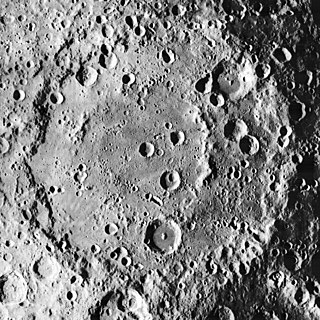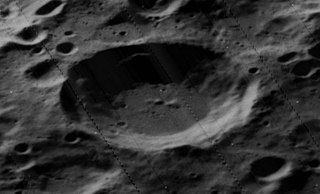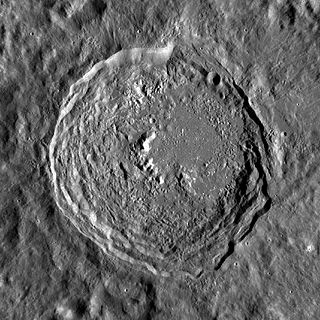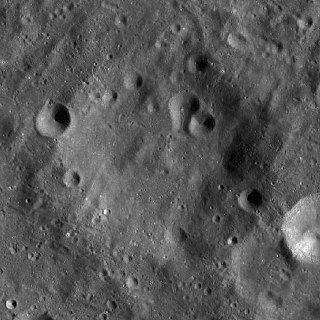 W
WAmici is a lunar impact crater that is located on the rugged far side of the Moon. It lies to the south of the larger crater Icarus, to the north of McKellar.
 W
WBarringer is a lunar impact crater that is located on the southern hemisphere on the Far side of the Moon, named after geologist Daniel Barringer. It is attached to the north-northeastern rim of the walled basin named Apollo, and lies to the southeast of Plummer. South of Barringer, on the floor of the Apollo basin, is the crater Scobee.
 W
WBok is a lunar impact crater that is located on the far side of the Moon. To the southeast is the crater Sniadecki; to the north is McKellar, and further to the west is De Vries.
 W
WCongreve is a lunar impact crater that is located on the far side of the Moon relative to the Earth, and lies across the lunar equator. It lies to the west-northwest of the massive walled plain Korolev. To the southeast is the crater Icarus, and due north is Zhukovskiy.
 W
WCrookes is a lunar impact crater that lies on the Moon's far side as seen from the Earth. It lies just to the southwest of the giant crater Korolev. To the southwest of Crookes is McKellar.
 W
WDas is a lunar impact crater on the far side of the Moon. It is located to the northwest of the walled plain Chebyshev. To the southwest of Das is the irregular crater Mariotte, and Von der Pahlen lies to the east-northeast. The crater was named after Indian astronomer Anil Kumar Das.
 W
WDe Vries is a lunar impact crater on the far side of the Moon relative to the Earth. It lies about midway between the craters Racah to the north-northwest and Orlov to the south-southeast. An nameless walled plain lies between De Vries and Orlov, with the perimeter of this feature joining the two rims.
 W
WDoppler is a lunar impact crater named for Christian Doppler that is located at the southern edge of the walled plain Korolev, on the far side of the Moon. To the east are the craters Das and Galois. Farther to the southwest of Doppler is Mohorovičić.
 W
WGalois is a large lunar impact crater on the far side of the Moon. Features of this class are commonly termed walled plains, due to their appearance and dimension. It is located just to the southeast of another huge walled plain, Korolev, a formation nearly double the diameter of Galois. Several hundred kilometers due south is another enormous feature, Apollo.
 W
WIcarus is a lunar impact crater that lies on the Moon's far side. It is located to the west of the huge walled plain Korolev, and less than two crater diameters to the east of the crater Daedalus. To the south of Icarus is the smaller Amici.
 W
WKorolev is a large lunar impact crater of the walled plain or basin type. It is named for Soviet rocket engineer Sergei Korolev. It lies on the far side of the Moon, and the northern part of its floor crosses the lunar equator. Notable nearby craters include Galois just to the southeast, Das to the south-southeast, Doppler attached to the southern rim, and Kibal'chich to the northeast. Rays of the crater Crookes cover parts of the basin.
 W
WLacus Oblivionis is a small lunar mare on the surface of the Moon. It is located at 21.0° S, 168.0° W and is 50 km in diameter. The name was adopted by the IAU in 1976.
 W
WLeeuwenhoek is a lunar impact crater that lies in the Moon's southern hemisphere, on the far side from the Earth. It is located to the east of the crater Birkeland and the unusual double crater Van de Graaff. To the northeast of Leeuwenhoek is Orlov and to the south is the large walled plain Leibnitz.
 W
WLodygin is a lunar impact crater to the southeast of the much larger crater Galois. To the east-northeast is the crater Paschen, and to the south-southwest is the immense Apollo.
 W
WMariotte is an elongated crater that is located on the far side of the Moon, named after the physicist Edme Mariotte. This formation is located about one crater diameter to the southwest of the smaller Das. This crater is longer to the southeast by about an extra 5 km, giving this feature an egg-shaped outline. The outer rim is sharp-edged and little eroded. The interior floor is uneven, particularly toward the southeastern end. To the southeast of Mariotte is the large crater Chebyshev.
 W
WMcKellar is a lunar impact crater on the Moon's far side, and it cannot be viewed directly from the Earth. It lies to the southwest of the crater Crookes, and the ray system from this impact covers the floor and sides of McKellar. To the south is the slightly smaller Bok.
 W
WMechnikov is an impact crater on the far side of the Moon. It is located just to the northeast of the much larger walled plain Galois, being separated by a stretch of irregular terrain about 20–30 km in width.
 W
WMurakami is an impact crater on the far side of the Moon. To the south-southeast is the crater Mariotte. Murakami partly overlaps the western rim of the satellite crater Mariotte Z. To the southeast of Murakami, and to the northeast of Mariotte, is the smaller crater Das. This is a roughly circular, bowl-shaped formation. There is some erosion along the rim, including smaller craters overlapping the rim edge to the south and northeast. There is a white patch of higher-albedo material just to the west of Murakami.
 W
WOrlov is a lunar impact crater. It is located on the Moon's far side, to the northeast of the larger crater Leeuwenhoek. To the north-northwest of Orlov is De Vries, and to the east-southeast is Rumford.
 W
WPaschen is a lunar impact crater on the far side of the Moon. The relatively large satellite crater Paschen M partly overlies the southern rim of Paschen, and they nearly form a merged pair with only a section of irregular terrain along their common border. The smaller but well-formed crater Paschen S lies across the southwestern rim of Paschen. As a result, most of the southern rim of Paschen is now gone.
 W
WPlummer is a lunar impact crater. It is located on the far side of the Moon from the Earth, to the north of the huge walled plain Apollo. Less than one crater diameter to the north of Plummer is the similar-sized Wilsing.
 W
WRacah is a lunar impact crater on the far side of the moon. It lies almost due south of the larger crater Daedalus, and lies across lunar longitude 180°W, i.e. the longitude that is diametrically opposite to the Earth. To the west-southwest of Racah is the crater Aitken, and to the southeast lies De Vries.
 W
WRumford is a lunar impact crater that lies on the far side of the Moon. It is located to the northwest of the large crater Oppenheimer, and to the east-southeast of Orlov.
 W
WSechenov is a lunar impact crater on the far side of the Moon. It lies to the southwest of the huge walled plain Hertzsprung, and to the east-southeast of the crater Timiryazev. To the south-southeast of Sechenov lies Paschen.
 W
WSniadecki is a lunar impact crater on the far side of the Moon. This is a circular, bowl-shaped feature that is not overlain by any significant impacts. However the larger satellite crater Sniadecki Q is attached to the southwestern outer rim and has disrupted the rim edge somewhat. There is also a small crater attached to the western outer rim.
 W
WSternfeld is a lunar impact crater on the far side of the Moon. It lies to the south-southwest of the crater Paschen, and to the east-southeast of the smaller Lodygin.
 W
WTimiryazev is a lunar impact crater that is located just to the east of the huge walled plain Korolev, on the far side of the Moon. It lies to the west-northwest of the crater Sechenov and north-northeast of Mechnikov.
 W
WVavilov is a prominent impact crater that is located to the west of the walled plain Hertzsprung. It is located on the far side of the Moon and cannot be viewed directly from the Earth. About a crater diameter to the northwest is the smaller Chaucer, and farther to the southwest is Sechenov.
 W
WWan-Hoo is a lunar impact crater that is located on the Moon's far side, and it cannot be seen directly from the Earth. It lies to the southwest of the huge walled plain Hertzsprung, within the outer skirt of ejecta. Just to the south-southwest of Wan-Hoo is the larger crater Paschen, and a little over two crater diameters to the northwest is Sechenov.
 W
WWilsing is a lunar impact crater on the far side of the Moon. It lies due north of the crater Plummer, and farther to the north of the huge walled plain Apollo. Wilsing is located just inside the rim of the immense South Pole-Aitken basin.